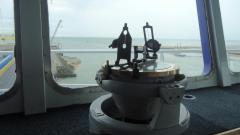A recent trip to Cherbourg to stay with the Lacour family and continue my book research meant that I was able to travel back to Ouistreham with Thierry Lacour, a Brittany Ferries commandant, who invited me to make the passage back to England on the bridge of the 'Normandie' on Thursday.
Before leaving I had arranged to spend a day with Olympic met guru David Lanier, who was coaching 420s in the river Orne, where we spent the session practising roll-tacking and then doing some race starts, in the first light breeze of the week.
Then to the port to meet Thierry on the 'Normandie' and watch the careful professionalism of the departure into the narrow channel at Ouistreham, which has a strong cross-current; orders to the helmsman for an occasional one-degree change of course keep the ship in the middle of the channel, until we reach the last cardinal mark and can go to autopilot.
After night fell, it was particularly interesting to observe the passage across the area of shipping mid-Channel, commentated by the officer of the watch; as the 'Normandie' made her way through the two zones, east and westbound, he explained how the instruments allowed him to keep the desired distance (around 1nm) from passing ships. The most difficult situation, he said, was when there were different types of vessel - cargo ships, fishing boats and, of course, yachts. The radar screens can be seen in the photos, and a constant visual check is maintained both ahead and on the screens. To echo my last article on the subject, it is very clear that an AIS transponder will ensure that your vessel is seen, and that the OOW will be able immediately to know your heading and speed - and your MMSI number if needed.
The approach to Portsmouth is always likely to be busy, and the ship went to manual outside the Nab Tower, reducing speed to match that of the ferry in front, the 'Norman Spirit' which has accompanied us most of the way, having come from Le Havre. Thierry resumes control for the entry, and a series of commands is repeated by the helmsman as we make our way up the main channel. After a slight delay while an Isle of Wight ferry sneaks out between the two ferries at the request of QHM, I am privileged to watch Thierry dock the ship using the controls on the wing of the bridge, while an officer on the stern calls the distance in to the ramp by the metre. Then it's everything off for a brief hour and a half before the team return to sea for the next crossing.
Before going to France, I was asked by club member Paul Wilson if I could find out about the Condor collision earlier this year, so I asked Thierry about it. He showed me the 'rapport technique' which is extremely detailed and which evaluates the various factors contributing to the collision. I will leave you to draw your own conclusions with this link (there is an English translation!):
http://www.beamer-france.org/BanqueDocument/pdf_290.pdf
Thanks to Thierry for a great trip and a great time in Cherbourg!
Steve Fraser
Submitted on 29th October 2011



